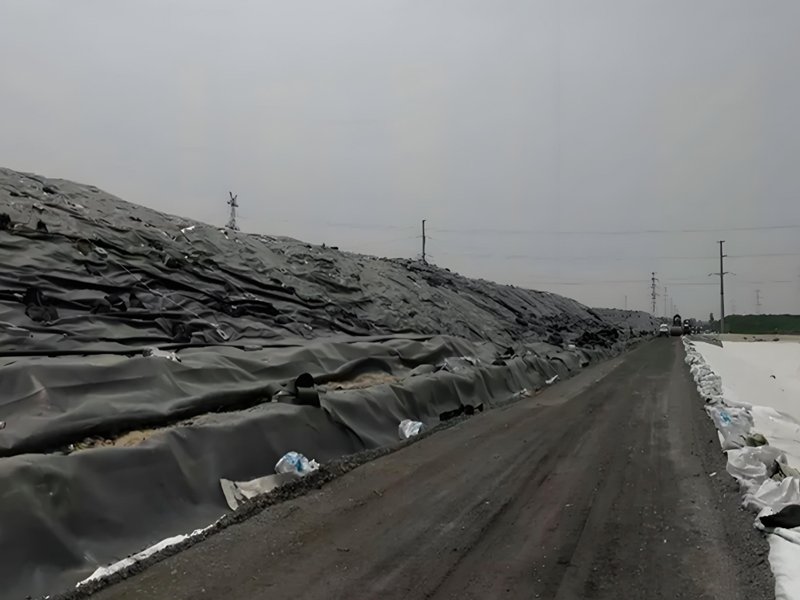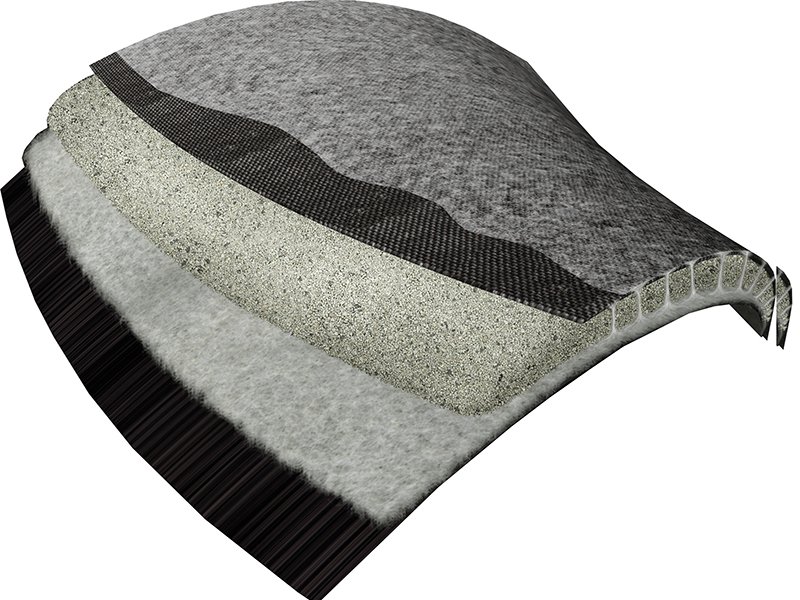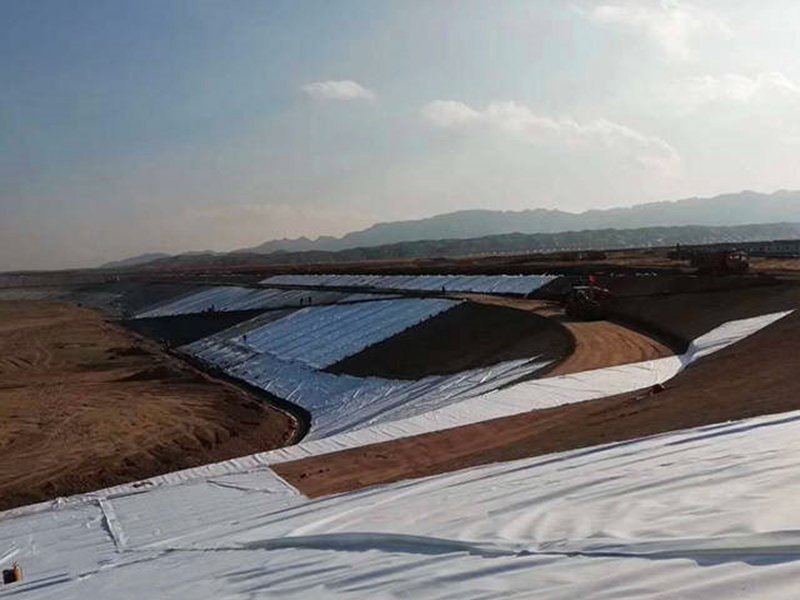A landfill liner, also referred to as a composite liner, is specifically designed and customized as a bottom liner system for landfills. Its primary purpose is to protect the soil and groundwater from contamination. The landfill liner incorporates various layers and components, including a leachate collection system, to effectively prevent the migration of pollutants and leachate into the surrounding environment. By containing and managing waste materials within the landfill, the liner system plays a crucial role in safeguarding the integrity of the ecosystem and preventing the potential adverse effects of contamination on soil and groundwater resources.
As the leading geosynthetics manufacturer and supplier, GEOSINCERE offer various types landfill liner with custom thickness and size at best factory price.
1. What Is Landfill Liner?
A landfill liner is an essential component of engineered landfill sites. Its primary function is to serve as a low permeable barrier that is placed beneath the landfill to retard the migration of leachate and its toxic constituents. Leachate refers to the liquid that forms as water interacts with the waste materials in the landfill.
The purpose of the landfill liner is to prevent the leachate from seeping into underlying aquifers or nearby rivers, thereby avoiding potential contamination of local water sources and sediments. This protection is crucial to safeguard the environment and prevent irreversible damage caused by pollutants.
With the increasing generation of solid waste, including production waste, domestic waste, commercial waste, and tourism waste, sanitary landfills have become a common method for the final disposal of urban waste. In modern landfills, a landfill liner is placed at the bottom and sides of the landfill and is continuously welded to provide a watertight seal as far as possible.
Typically, the landfill liner consists of a compacted clay layer with a specified thickness and allowable hydraulic conductivity. This clay layer is overlaid with a high-density polyethylene geomembrane, which serves as an additional barrier to prevent leachate migration.
While landfill liner systems are designed to delay the potential pollution of ground and surface water, it is important to note that the barriers are not considered foolproof. The United States Environmental Protection Agency has acknowledged that landfill barriers will ultimately fail over time, and the potential risks associated with landfill sites can persist for thousands of years.
Despite these challenges, the use of landfill liners remains a cost-effective approach to protect the subsurface environment and mitigate the immediate impact of waste disposal on water resources. Ongoing research and advancements in landfill design aim to improve the long-term effectiveness of these liner systems and minimize the potential environmental risks associated with landfills.


2. What Are Advantages of Landfill Liner?
Landfill liners play a crucial role in waste management by providing a barrier between the waste and the environment. They offer several advantages that contribute to the safe and efficient containment of waste within landfills. Here are the key advantages of landfill liner systems:
2.1 Tensile Strength
Tensile strength is an important property of landfill liners as it determines their ability to withstand tensile stress. Various tests, such as the uniaxial tensile test, wide-strip tensile test, and multiaxial tension test, assess the tensile strength of landfill liners. High-density polyethylene (HDPE) liners typically exhibit tensile strengths ranging from 225 to 325 lb/in, depending on their thickness. This strength ensures that the liners can withstand the forces exerted on them during installation and operation.
2.2 Tear Resistance
Landfill liners need to resist tearing, especially when exposed to high winds or handling stress during installation. Tear resistance is measured using ASTM methods, with typical values ranging from 40 to 60 lb for HDPE liners. This property ensures that the liners maintain their integrity even in challenging conditions, preventing the formation of tears that could compromise their effectiveness.
2.3 Impact Resistance
Falling objects in landfills can potentially tear or weaken the liner. Landfill liners, especially when combined with geotextiles, exhibit higher impact resistance. This means they can withstand the impact of objects and maintain their structural integrity. Thicker liners generally provide greater impact resistance, ensuring long-term durability and minimizing the risk of damage.
2.4 Puncture Resistance
Landfill liners must have sufficient puncture resistance to prevent penetration by sharp objects present in the waste. ASTM tests, such as the critical cone height test, measure puncture resistance. HDPE liners typically have a critical cone height of around 1 cm, indicating their ability to resist punctures. This property ensures that the liners remain intact, preventing the release of waste into the surrounding environment.
2.5 Environmental Stress Cracking (ESC) Resistance
ESC refers to the cracking of plastic materials when subjected to applied tensile stress below their short-term tensile strength. HDPE landfill liners are susceptible to ESC, but proper polymeric properties, such as molecular weight and orientation, enhance their resistance. ASTM D5397 provides a standard test method for evaluating the ESC resistance of HDPE liners. By ensuring ESC resistance, landfill liners maintain their structural integrity and prevent the formation of cracks that could compromise containment.
2.6 Regulatory Compliance
Landfill liner systems are often required by regulations to prevent environmental contamination. By implementing these systems, landfill operators ensure compliance with waste management regulations and demonstrate their commitment to responsible disposal practices. Landfill liners provide a physical barrier that helps contain contaminants, protecting soil, groundwater, and nearby ecosystems.
2.7 Long-Term Durability
Landfill liner systems are designed for long-term durability. They undergo laboratory-accelerated aging tests to assess their mechanical properties over time. The selection of materials, such as HDPE, with the appropriate strength and resistance to degradation, ensures that the liners can effectively contain waste for extended periods without compromising their integrity.
3. What Are Types of Landfill Liner System?
There are different types of landfill liner systems used based on the level of harmfulness associated with the type of waste being disposed of. The two main types of liner systems are single liner systems and double liner systems.
3.1 Single Liner Systems
These systems are commonly used in landfills that primarily contain construction rubble or non-hazardous waste. Single liner systems consist of one layer of liner material, typically a high-density polyethylene (HDPE) geomembrane. They provide a basic level of protection against the migration of leachate into the surrounding environment. However, they may not be suitable for containing harmful liquid wastes that can easily penetrate the liner.
3.2 Double Liner Systems
Double liner systems are employed in municipal solid waste landfills and hazardous waste landfills where there is a higher risk of contamination. These systems consist of two layers of liner material. The primary liner is designed to collect and contain leachate, preventing its migration into the ground. The secondary liner serves as a leak-detection system, providing an additional barrier to ensure that no contaminants leak into the environment.
In a double liner system, the leak-detection layer is typically composed of a landfill linermaterial such as HDPE or a geosynthetic clay liner (GCL). The leak-detection layer helps identify any breaches or leaks in the primary liner, allowing for timely repairs and preventing the spread of contaminants.
The selection of the appropriate liner system depends on the nature of the waste being disposed of and the level of protection required to prevent contamination of the surrounding soil and groundwater. It is important to adhere to regulatory guidelines and standards when designing and implementing landfill liner systems to ensure effective waste containment and environmental protection.
4. What Is Landfill Liner System Compose of?
A landfill liner system is composed of various components that work together to provide effective containment and protection against the migration of contaminants. The key components of a landfill liner system include:
4.1 Geomembrane
The geomembrane is a high-density polyethylene (HDPE) liner that acts as a primary barrier to prevent the movement of liquids and gases within the landfill. It provides a low permeability barrier and helps minimize the flow of inorganic contaminants. The geomembrane is typically installed on the bottom and sides of the landfill.
4.2 Geosynthetic Clay Liner (GCL)
The geosynthetic clay liner is made of sodium bentonite, a natural clay material with high swelling properties. The GCL is placed on top of the geomembrane and consists of two layers of geotextile enclosing a layer of bentonite. It acts as a secondary barrier, regulating the movement of liquids and gases within the landfill.
4.3 Leachate Collection System
The leachate collection system is designed to collect and manage the liquid waste (leachate) generated in the landfill. It typically consists of a network of pipes and collection channels that gather the leachate and direct it to a collection sump or treatment facility for proper disposal.
4.4 Drainage Layer
The drainage layer is placed above the leachate collection system and typically consists of materials such as gravel. It provides a pathway for the collected leachate to flow towards the collection pipes while allowing for proper drainage and preventing clogging of the system.
4.5 Leak Detection System
The leak detection system is an essential component that helps identify any breaches or leaks in the landfill liner system. It typically includes additional layers of materials, such as gravel, along with another landfill liner or a complex liner. The system is designed to detect and monitor the movement of liquids and gases, enabling early detection of any potential leaks.
4.6 Final Cover
The final cover is the top layer of the landfill liner system, placed over the waste to provide additional protection and closure. It is typically composed of materials such as soil, synthetic materials, or a combination of both. The final cover helps prevent water infiltration, controls gas emissions, and promotes long-term stability and environmental compatibility.
Landfill liner systems create a multi-layered barrier that minimizes the migration of contaminants into the surrounding environment, protects groundwater quality, and ensures proper waste containment and management by combining these components.


5. How Dose Landfill Liner Work?
A landfill liner works by creating a barrier between the waste in the landfill and the surrounding environment, preventing the migration of contaminants and minimizing the risk of water pollution. Here’s how a landfill liner system typically works:
5.1 Containment Structure
The landfill is constructed with a containment structure, which consists of a base and sides. The base is typically prepared by compacting the soil or other suitable materials to provide stability and prevent the migration of waste downward.
5.2 Geomembrane Placement
A geomembrane, typically made of high-density polyethylene (HDPE), is placed on the prepared base and extended up the sides of the landfill. The geomembrane acts as a primary barrier, preventing the movement of liquids and gases from the waste into the surrounding soil and groundwater.
5.3 Geosynthetic Clay Liner (GCL)
On top of the geomembrane, a geosynthetic clay liner (GCL) is installed. The GCL consists of bentonite clay sandwiched between layers of geotextile. The GCL acts as a secondary barrier, regulating the movement of liquids and gases and providing additional protection against leaks.
5.4 Leachate Collection System
A leachate collection system is installed above the GCL. This system consists of a network of pipes and collection channels that collect the liquid waste (leachate) generated by the decomposition of waste materials. The leachate is directed to collection sumps or treatment facilities for proper disposal.
5.5 Drainage Layer
A layer of granular material, such as gravel, is placed above the leachate collection system. This layer provides a pathway for the collected leachate to flow and prevents clogging of the system.
5.6 Final Cover
Once the waste reaches a certain height, a final cover is applied to the top of the landfill. The final cover typically consists of soil, synthetic materials, or a combination of both. It helps prevent water infiltration, controls gas emissions, and provides long-term stability to the landfill.
The landfill liner system works by effectively containing the waste within the designated area, minimizing the movement of liquids and gases through the layers, and directing the leachate for proper treatment and disposal. By creating this barrier, the landfill liner system helps protect the surrounding environment, including soil, groundwater, and nearby ecosystems, from potential contamination.
6. About GEOSINCERE
GEOSINCERE is the professional landfill linerand geosynthetics manufacturer and wholesaler located in Shandong Province, China. We are an professional manufacturer, exporter and wholesaler for such geosynthetic products as geomembanes, geotextiles, geogrids, geocells, geosynthetic clay liners (GCLs), drainage boards, etc.
We can provide customers with most extensive lines of geomembranes and geotextiles for projects as civil engineering, Gold mining, Copper Mining,Road Construction,Landfill, Agriculture and aquaculture engineering applications. GEOSINCERE brand and other geosynthetics products and solutions can meet your requirements by our solid technologies, innovative engineering solutions and excellent customer services.






Leave A Comment